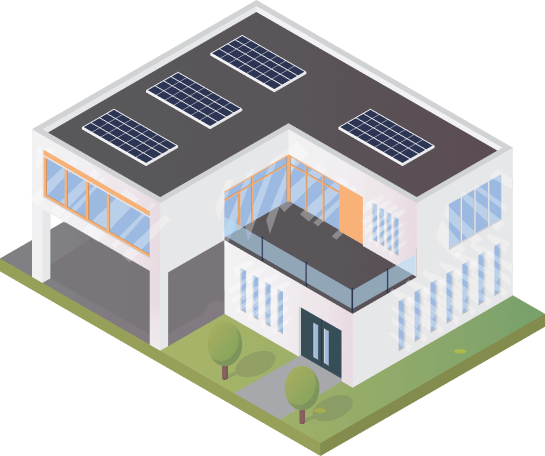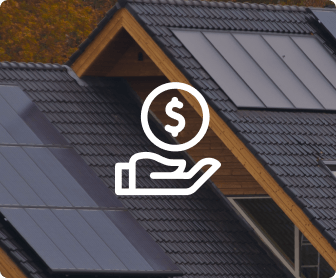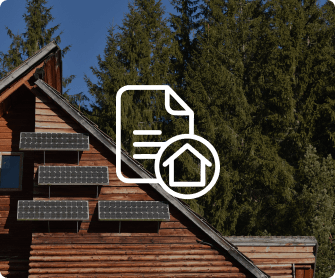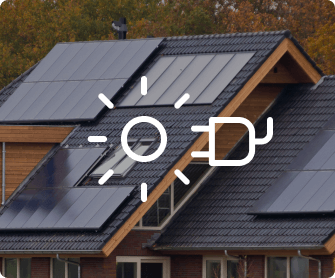Why Solar Power?
Flip Your Power Bill Into A Savings Account. Solar Saves You Big Money & The Environment!
The Future Is Green
Which Side Of History Will You Be On?
Going solar isn’t just the right thing to do – it’s also about taking control of your finances and making a ton of money on what’s usually just another bill every month.
Homeowners in the know are saving tens of thousands of dollars on their energy bills and tucking their solar into a little nest egg that’s either going to increase the value of their homes when they sell or give them power for life if they stay.
Will you be kicking yourself in 20 years when you’re paying at least double what you are now for power because of inflation? Banking on solar is banking on yourself.

Your power bill is a sunk cost, a payment you make every month that goes to the power company and you get nothing in return, except power. When you go solar power, you are paying for your solar panels so that month by month, you’re owning your own power. When your solar panels is paid off, then you have free solar power for life.
Solar panels are a fixed cost, that means you own your solar power and the cost dont go up! Inflation makes everything go up in price because the dollar slowly loses its value, like how gasoline was only $1.50 per gallon in the year 2000. That wasn’t very long ago! By the time you finish paying off your solar at your low fixed-rate price, your power bill would have more than doubled. That’s a real savings.
Every single state in the USA has experienced energy inflation, and will continue to. In California, the average price per kWh of electricity jumped from $0.07 cents per hour in the year 2001, to double that at $0.14 cents per kWh in 2021. Families who had the insight to go solar back in 2001 have enjoyed paying a much less expensive fixed rate on their solar loan – which is almost over and they will soon have free power for many years to come. The earlier you go solar, the more you can save!
When you go solar power, your house is still hooked up to the power grid. That means that even at night, or during a rainstorm, you will always have power, the same as your neighbors. Net Metering is the way that you can produce extra energy during the daytime and sell it to your neighbors for credits, then use those credits when you need power from the grid. For instance, if your house uses 10,000 kWh of electricity per year, your solar power system should produce 10,000 kWh during the daytime. With the excess that you’re not using, you “sell” the energy back to the grid and your meter spins backward. When you need to use power at night, you simply swap those credits for electricity.
What Are My Solar Options?

Buy it!
Solar Loan
The most common way to buy into solar is to take out a solar loan to help cover the upfront cost of putting the system on your roof and start saving you money.
We work with the top financiers, who offer the best rates and most value for your solar needs. With most loan types, you will pay less with solar right from the start, then continue saving as inflation skyrockets the price of power while you’re still paying the much lower fixed rate of your solar loan.
Even better, as you pay down the loan you’re increasing the value of your home. It unlocks the ability for you to finally take back your power and pay yourself, rather than endlessly pay for utilities.

Lease it!
Solar Lease
The reasons you would lease your solar panels are the same reasons you might lease a car.
Leasing Requires Less Upfront Money.
You may have lower costs at the start to get solar onto your roof with a lease. People with poor credit, no downpayment, or who have a lower tax liability and don’t qualify for the Investment Tax Credit for owning their solar may benefit from this option. You might be waiting for newer solar technology to come out before you buy, or simply not be ready to commit to another loan.
The cool thing about leasing solar vs. a car is that there’s no mileage on panels – you get the ability to produce unlimited energy with zero penalties.

Pay less!
Power Purchase Agreement (PPA)
This option allows us to put our solar panels on your roof without you owning the system.
A PPA is similar to a lease in that you get the solar onto your roof with no upfront costs, down payments, or loans. The major difference is that you’re neither leasing nor owning your solar panels.
With this model, you can get our best solar panels on your roof, but we take all the responsibility for ownership. You sign a contract in advance that guarantees a locked-in low rate for you to buy inexpensive solar from our system, which will be much lower than buying power from your utility provider, especially over time.
Big Tax Breaks For Green Energy
Free Money While It Lasts
When you purchase solar right now, the government is offering you a tax break for 30% of the entire cost of your system.
No strings. That’s your money.
Use it how you want can, collect it over a time period or put it back into your solar loan.
Now is the Time for Solar
What About My Roof?
We offer a 10-year warranty and labor guarantee on your roof, after inspection. After thousands of solar installations, we’ve never had a leak or repair due to a faulty install. We take pride in setting up your house and your family for a lifetime of success in clean energy, and that includes protecting the roof that’s protecting your family.
What If I Sell My House?
You have two options if you decide to move and sell your home:
- You can have the new homeowner sign off and take over payments
for the solar. - You can include the solar in the sale of your home and sell it for more money, increasing your property value. You then take a small portion of that money to pay off the rest of your solar loan and pocket the rest.
What Does Solar Cost?
Solar costs you $0 out of pocket for a lifetime of clean energy for your home. Compared to your power bills, solar costs much less per month, especially as inflation increases those power bills. Solar families pay only their solar loan each month – much less than their power bill. The out of pocket cost is simply trading the high sunk-cost of power bills into the lower ownership cost for solar.
Who Is Responsible For Repairs?
Our systems come standard with a 25-year warranty. If for any reason your solar or any of the system equipment malfunctions, we will repair it, free of charge, with no out-of-pocket cost on your end. We also put our panels through a thorough inspection and functional testing before they’re set onto your roof.
Why will you choose Titanium Solar to help you go solar? You can pick your reasons from the following:
- Save money with the best prices
- Increase the value of your home
- Peace of mind with the best warranties
- No hassles with easy installs
- Produce clean energy for your family
- Reduce your carbon footprint
Find out how much money you can make by going solar today!
Reviews from our customer
Get the info you need to make an informed decision.
Frequently Asked Questions
What will solar cost me? 
Solar is not a cost – it’s an opportunity to invest in your future.
The real question is, what will doing nothing cost you? Tens of thousands of dollars over the next two decades. If you qualify for financing, our solar install panels and equipment are installed free of charge, with no payments for 60 days (so you actually save money right away, often with a free month of power).
Once your solar is locked in and 100% operational, it generally costs less than your utility bill, staying the same rate until it’s paid off – while your power bill would increase with inflation over time.
What Happens to My Roof?
Once you lock in solar, a site inspector will visit your house to take pictures and measurements to ensure your roof integrity. The next step is that the installers will come strap your system down to the roof.
Our systems come with a 10-year penetration warranty for all of our panels and equipment, to protect you from possible leaks (which we have never had an issue with, but we guarantee your safety for your peace of mind).
Who Repairs and Maintains My Solar?
We offer you a 25-year industry-leading warranty on all panels, electrical equipment, and inverters.
You are 100% covered for any and all equipment malfunctions, without a single penny in out-of-pocket costs for labor, repair, or service.
What If I Move?
We know that some homeowners will relocate and the solar stays with the house. But you’re still covered. Here are two likely scenarios:
If you move within 10 years of buying solar, the new homeowners can take over your payments where you left off. They benefit from low power bills since the rates will have increased since the moment you went solar. This actually makes solar homes more attractive to buyers.
After 10 years, more than 50% of your solar system will be paid off. You can simply roll the sticker price of solar into your home, then pay off the rest of your solar loan with the increase in money that you made from the sale. Fully paid off solar is extremely attractive to buyers, plus you get to reimburse yourself for the many years that you paid off your solar loan, rather than just paid in money to the bank.
For people with PPA solar, this agreement can transfer to the new owner after 10 years.
How Much Can I Make On Solar?
Homeowners who go solar save $20,000-$50,000 over the 25-year payment plan for their solar install, depending on their needs.
Once a system is paid off, you can get thousands of dollars per year in savings, for the estimated 50-year life of your panels! A representative will give you a more accurate quote based on the size of your home, and your energy needs.
